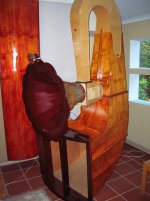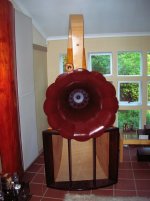Incidentally how do you find the SEAS FA22RCZ for use in open baffle, compared to other drivers such as Fostek etc?
My own experience is that the FA22RCZ does a pretty goob job with bottom
end, better than the Fostex and most of the others. For this reason it is
one of the few FR's that I have used without a woofer.
I like it with amplifiers having a lower damping factor, maybe 2 to 4, and
usually tweak the top end with a little RC loading across the terminals.
I think you can do better, but not at the price. And of course you can add
a sub and a good high frequency driver.
Oon - "full-range / wide-band" drivers are often selected for use in OBs with woofers - this particular SEAS is somewhat larger than those usually implemented, and based on your comments in other threads, you might find them lacking in the top octave or two.
The most common approach I've seen with these types of projects has been running the woofer(s) - ie sometimes 2 per channel - on the same OB as well, but there's probably no reason not to a least experiment with sealed bass drivers - particularly as you already have something on hand . I think how much OB benefit you'd retain would depend on the selected XO point - start experiments in around 200Hz
If you haven't experienced an OB system before, this would certainly be a quick taste test. Keep in mind that for a variety of reasons they (OB) don't work for everyone .
Active XO and bi-amping is certainly a very flexible approach - with sufficient power and level controls on each amp, differences in driver sensitivity become moot.
I'd still be inclined to HP filter the wide-bander to improve power handling / reduce excursion problems.
Thanks ChrisB, just got my unit yesterday, didn't have a chance to test it out. I probably would add in something to supplement the top end. Although full rangers can be pretty good int he top end, I feel that the slight weakness int he top end prevents the speaker from "being all that it can be..."
I am familiar with the 2X 15" eminence beta solution with one metre panels, however I think the missus is not going to like the idea at all... At least with the sealed enclosure I can get decent bass. My only worry is the bass may seem boxy and negates all the benefits of a nice OB fullrange.
 My first try will the sealed box, will see how that goes...
My first try will the sealed box, will see how that goes...Oon
My own experience is that the FA22RCZ does a pretty goob job with bottom
end, better than the Fostex and most of the others. For this reason it is
one of the few FR's that I have used without a woofer.
I like it with amplifiers having a lower damping factor, maybe 2 to 4, and
usually tweak the top end with a little RC loading across the terminals.
I think you can do better, but not at the price. And of course you can add
a sub and a good high frequency driver.

Hi Mr. Pass,
I have no doubt the FA22RCZ can do great bass, just by looking at the charts. However, looking at your speaker projects, all I can say is size does matter....
As much as I would like to do a big baffle, but the baffle I had in mind is going to be kinda skinny. You have to understand my enitre apartment might be the size of your living room. I might try to widen it up a bit, give it an extra 10 cm or so to make it 40~50cm. Narrow it down at the base so the missus still think it is not too big...
What the consequences if I folded the sides in a bit, sort of like making a speaker without the back, will it still work as well as one which is completely flat and big?
I don't think my amplifier has a damping factor that low, but I will add in a resistor in series, to lower it. I am mostly running tripath digital amps, although I do have a valve amp, unfortunately the valve amp is humming away and I haven't had time to figure it out... Will want to build the F1 or F2 one of these days...
Oon
OBs
Ok Here they are at long last. Interesting, but I am not won over.... Sound orienting from the carpet fails to impress and the bass is best described as light. Who said they go down to 30 hertz ? The roll off is more in the 80htz region which I would expect. Oh, and things of beauty they are certainly not either, but a simple build and a bit of fun to make.
I would love to hear from anyone who has heard the Woden cabinets WD-SEAS-SD22-MLTL for these drivers, think that's the next step, unless I hear contrary from anyone on these pages.
Later.

Ok Here they are at long last. Interesting, but I am not won over.... Sound orienting from the carpet fails to impress and the bass is best described as light. Who said they go down to 30 hertz ? The roll off is more in the 80htz region which I would expect. Oh, and things of beauty they are certainly not either, but a simple build and a bit of fun to make.
I would love to hear from anyone who has heard the Woden cabinets WD-SEAS-SD22-MLTL for these drivers, think that's the next step, unless I hear contrary from anyone on these pages.
Later.

Ok Here they are at long last. Interesting, but I am not won over.... Sound orienting from the carpet fails to impress and the bass is best described as light. Who said they go down to 30 hertz ? The roll off is more in the 80htz region which I would expect. Oh, and things of beauty they are certainly not either, but a simple build and a bit of fun to make.
I would love to hear from anyone who has heard the Woden cabinets WD-SEAS-SD22-MLTL for these drivers, think that's the next step, unless I hear contrary from anyone on these pages.
Later.

Hello!
Well the bass does go down to 30 cycles - I have them rear horn loaded - 30 cycles Fc and front horn loaded 150 cycles Fc.
In such a system one does not need any filters and I augment with a T925 at 15 kcycles.
Correctly loaded these have to be the sleeper bargain of the last decade in terms of FR drivers.
The trick is correctly loaded....
On an OB, as you have them by the looks, the size of the baffle dictates the roll off frequency....so moving to the ML-TL would definitely bolster the low end!!
WM
Thanks WM,
I did contact Woden Designs and he said he didn't like the SEAS driver, but then admitted that this might have been due to the cabinets they were in. So big question is - are these cabs the ones he did not like ? Probably ! On paper SEAS do not recommend such a large internal volume as his design has twice the volume. So I'm in limbo-land... help !
I did contact Woden Designs and he said he didn't like the SEAS driver, but then admitted that this might have been due to the cabinets they were in. So big question is - are these cabs the ones he did not like ? Probably ! On paper SEAS do not recommend such a large internal volume as his design has twice the volume. So I'm in limbo-land... help !
Thanks WM,
I did contact Woden Designs and he said he didn't like the SEAS driver, but then admitted that this might have been due to the cabinets they were in. So big question is - are these cabs the ones he did not like ? Probably ! On paper SEAS do not recommend such a large internal volume as his design has twice the volume. So I'm in limbo-land... help !
Well here are the pics - these cabs were not originally made for Seas drivers, but I have been through many FR drivers - most of them exotic (costly) - but the Seas really are good...
Attachments
An 8" on an open baffle will never have good bass. But any speaker in a rear loaded horn designed for it will have excellent bass down as low as you want it to go. The only variables are how big are you willing to go and how loud do you want it to go. The Seas driver is definitely capable of loud bass down to 30hz if the horn is designed properly for the driver. All these people who keep asking will such and such horn designed for one driver will work for this other driver frustrate me to no end. Designing a horn for a particular driver is much easier than trying to build someon elses horn designed for a different driver, and will of course sound better too. I've taken cheesey full range drivers from old cars design a good rear loaded horn and ended out with better sound than anything you could find at any big box store.
Okay I misspoke, open baffel designs can have clean natural sounding bass but not at great volume (with an 8") and certainly not with the dynamics you get with a horn. Also a properly done horn can give you that same natural tone as open baffel with greater dynamics and lower distortion to boot. Properly done being the key here. Whereas it's prettyhard to screw up an OB design.
Designing a horn for a particular driver is much easier than trying to build someon elses horn designed for a different driver, and will of course sound better too.
Any suggestions for FA22RCZ?
Hi,
I am running the SEAS open baffle. IMHO you should just run it as it is. You would need woofer assistance though. Most of the time you need a low cut to reduce the excursion of the full range such as fostex. The SEAS comes with an unusually high xmax of +-3mm for a speaker of this class.
Oon
Sent from my MB860 using Tapatalk
I am running the SEAS open baffle. IMHO you should just run it as it is. You would need woofer assistance though. Most of the time you need a low cut to reduce the excursion of the full range such as fostex. The SEAS comes with an unusually high xmax of +-3mm for a speaker of this class.
Oon
Sent from my MB860 using Tapatalk
Nicoch, does that mean another amp is required for doing the work below the X-O ƒ?
I wonder which value I should use if I were to cap the input of the amp. What's the typical nominal impedance of an amp? Does it change as the frequency changes or does the lautsprecher's impedance interfere? I had thought of having a simple X-O at the input but gave up as I knew too little about it.
I wonder which value I should use if I were to cap the input of the amp. What's the typical nominal impedance of an amp? Does it change as the frequency changes or does the lautsprecher's impedance interfere? I had thought of having a simple X-O at the input but gave up as I knew too little about it.
- Home
- Loudspeakers
- Full Range
- Seas FA22RCZ full range project


